If you’re a runner or planning to become one, choosing the right pair of running shoes is a crucial decision.
Two renowned brands, HOKA and Brooks, offer a wide array of running shoes, each with its unique features and benefits.
In this comprehensive guide, we’ll delve deep into the HOKA vs Brooks running shoes comparison, shedding light on the key factors that differentiate these brands.
HOKA and Brooks have earned their stripes as respected running shoe manufacturers, with both brands holding the prestigious acceptance of the American Podiatric Medical Association (APMA).
This signifies the quality and design excellence inherent in their running shoes.
While there isn’t a definitive “better” brand between the two, understanding their differences will help you make an informed choice based on your specific needs and preferences.
You May Also Like – HOKA vs ASICS: Which Brand is Best For You?
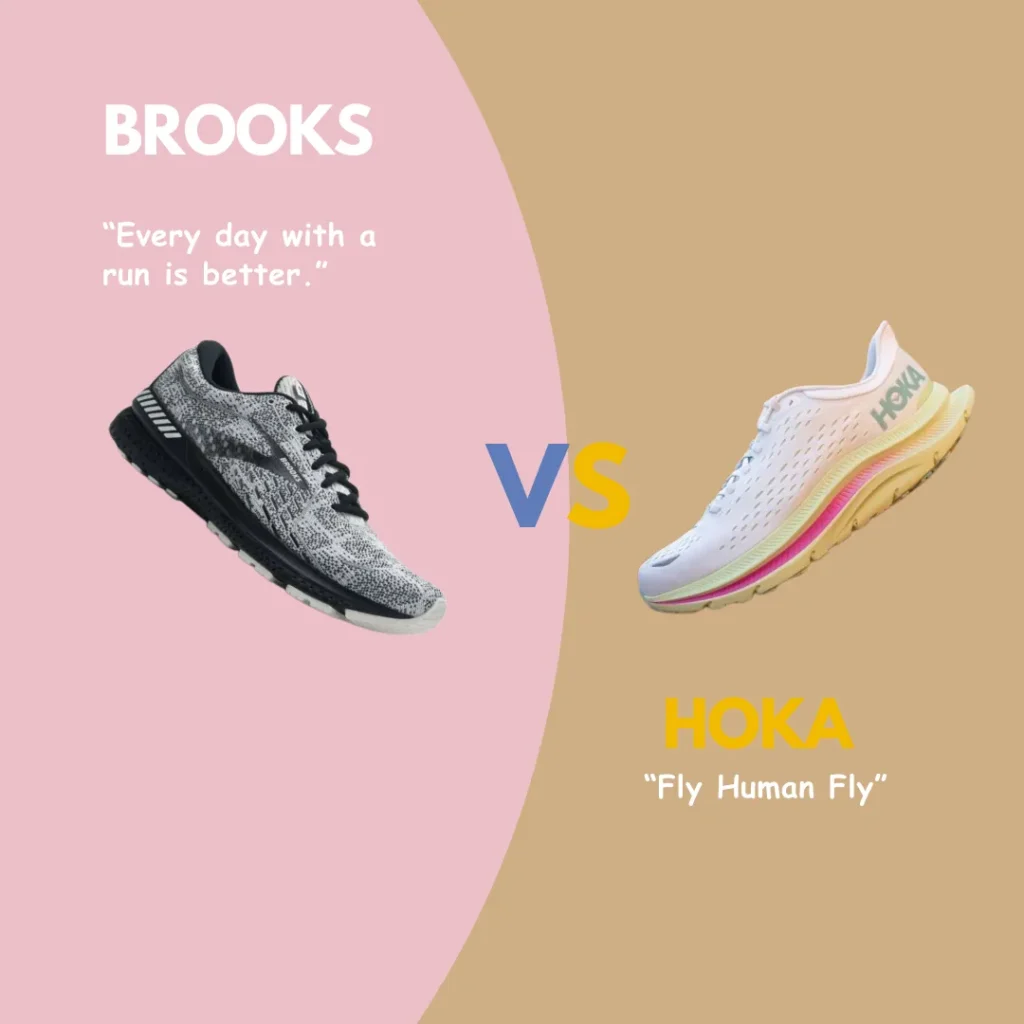
HOKA vs Brooks – The Key Differences
The primary divergence between HOKA and Brooks running shoes lies in their style and design philosophy.
HOKA is renowned for its maximalist running shoes, characterized by a substantial sole with ample cushioning, resulting in a thicker appearance.
In contrast, Brooks focuses on crafting more traditional running shoes with varying levels of support and pronation control.
The distinct appearance and cushioning of HOKA shoes make them a favorite among runners seeking enhanced joint-impact forgiveness, particularly among masters, ultrarunners, and trail enthusiasts.
Brooks, on the other hand, is trusted by competitive and recreational runners alike.
Also Read – Brooks vs Asics: The 7 Key Differences Between Brands
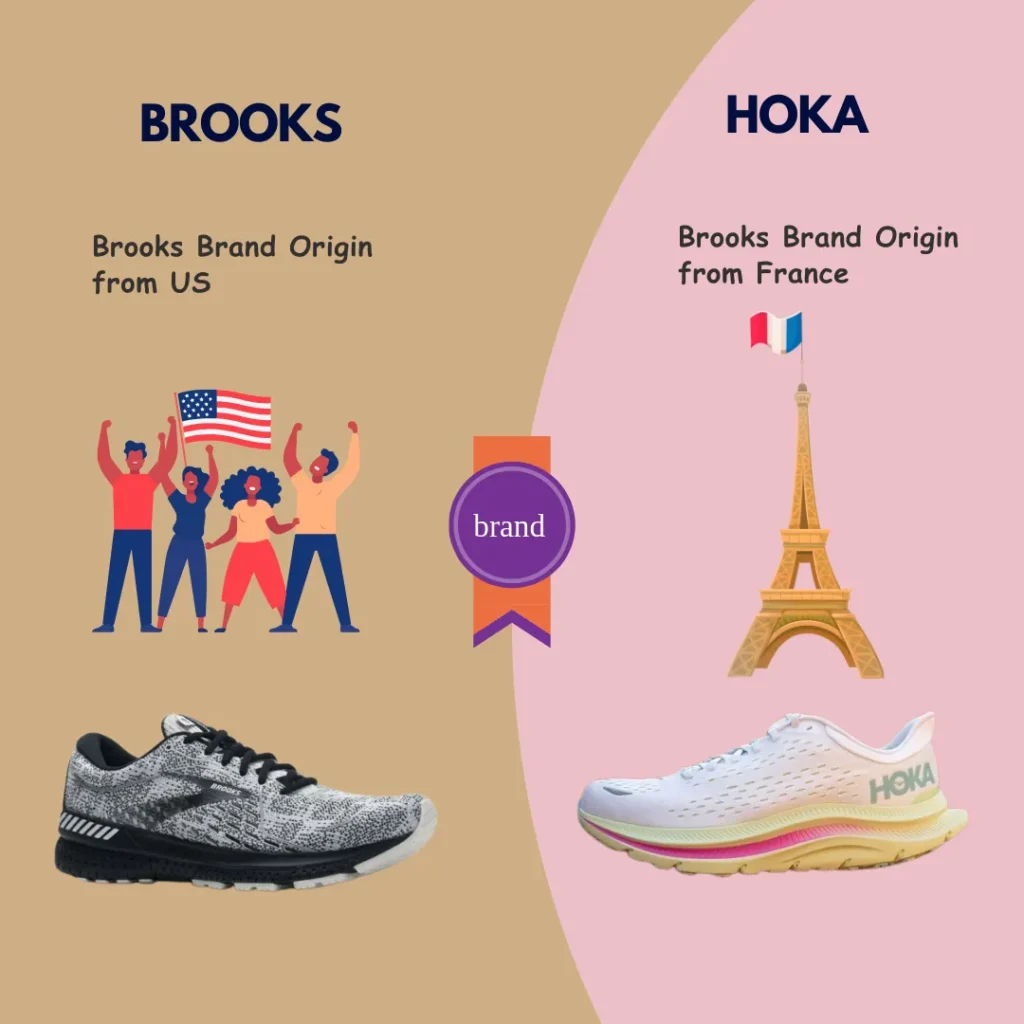
Durability
The durability of running shoes depends on several factors, including body weight, terrain, running frequency, gait, and shoe rotation.
Both Brooks and HOKA running shoes typically fall within the recommended lifespan of 300 to 500 miles (500-800 km).
However, HOKA shoes may perform best on trails, wearing down faster on roads.
If you’re primarily a road runner, opting for road-specific HOKA models is advisable.
In terms of longevity, Brooks tends to approach the 500-mile mark, while HOKA shoes may last around 400 miles per pair.
Read Also – Asics vs Nike: Which Brand is Right for You?
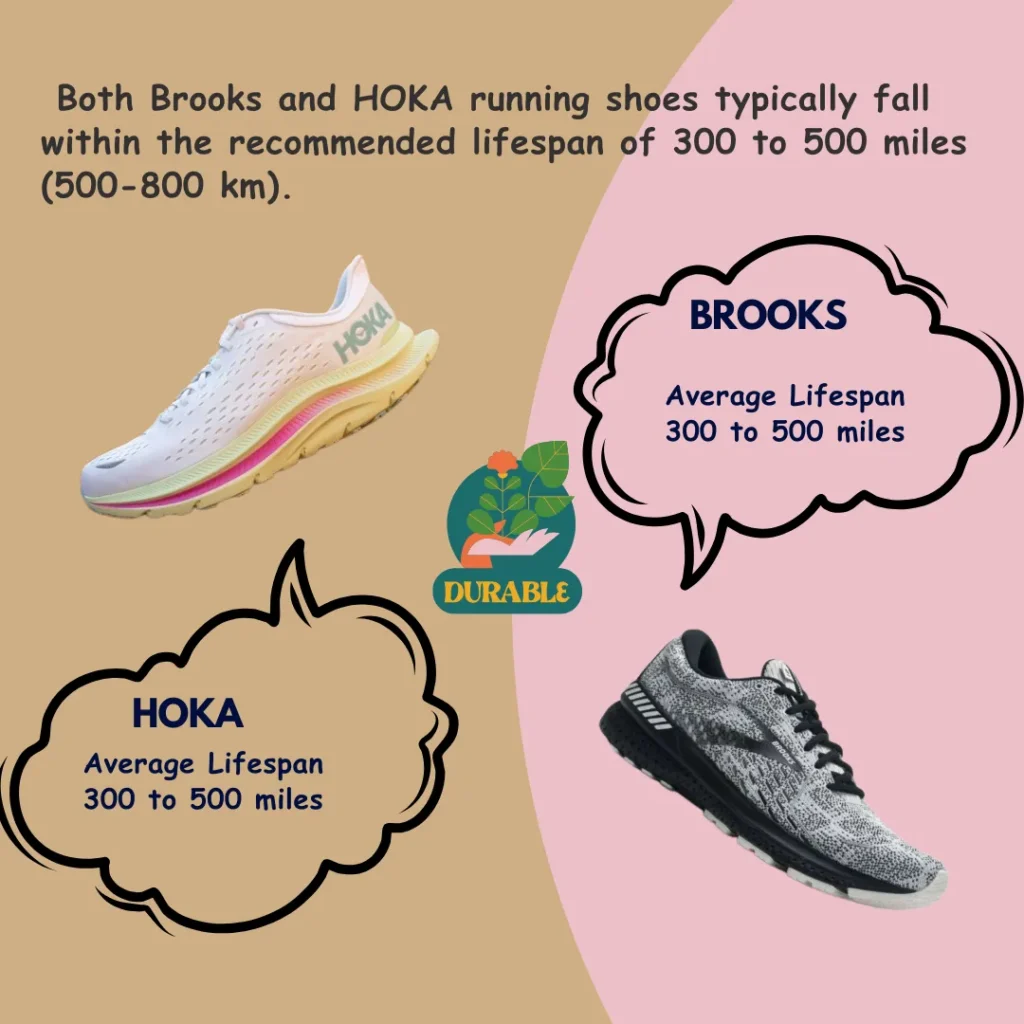
Fit and Sizing
Brooks and HOKA differ significantly in fit and sizing.
Brooks suggests sizing up by half a size from your street shoe, offering a wider toe box that benefits runners with specific foot conditions like bunions or metatarsalgia.
HOKA, conversely, is known to fit true to size and leans towards a narrower design.
However, both brands offer wide options for certain models to cater to a wider range of foot shapes and sizes.
Also Read – Hoka Bondi 8 vs Gaviota 5: Unveiling the Ultimate Comparison
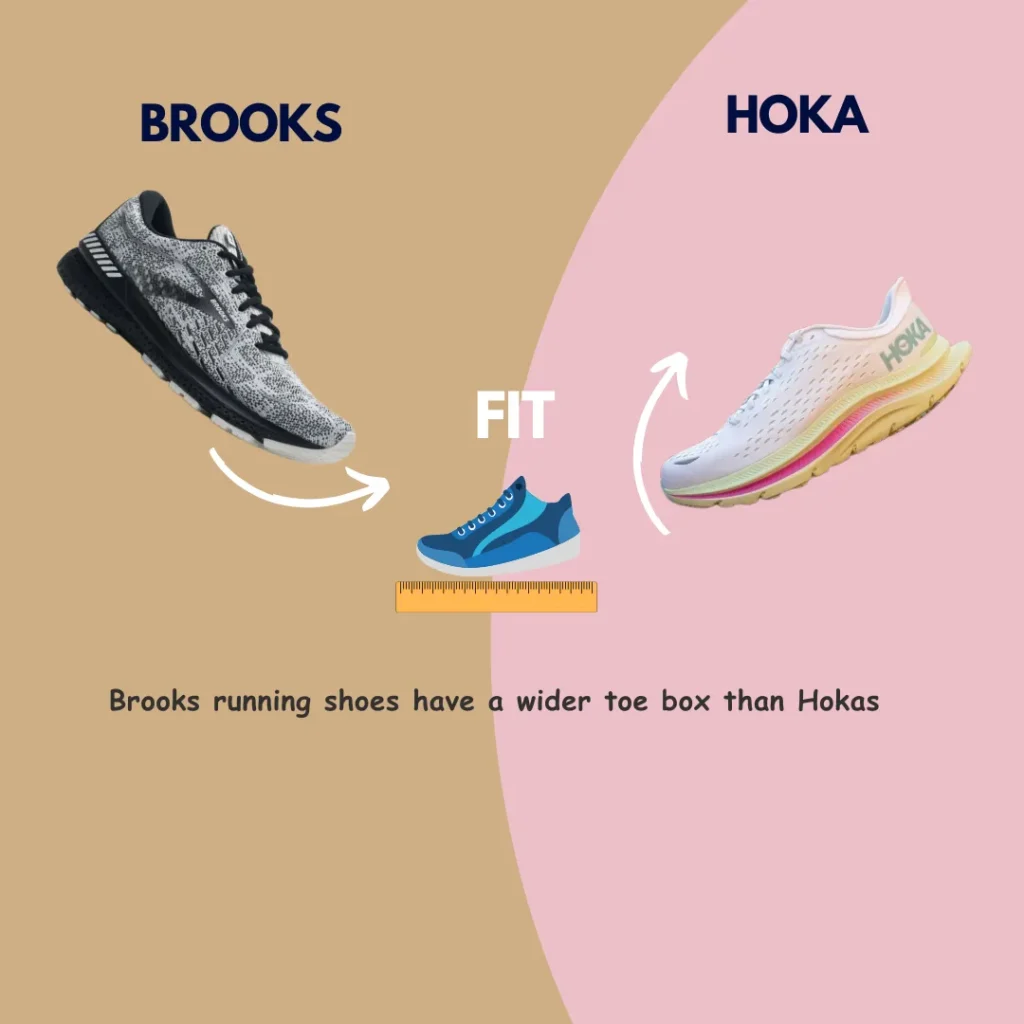
Cushioning
Cushioning is a critical factor in running shoes, and HOKA and Brooks take distinct approaches.
HOKA is famous for its plush “marshmallow softness” due to PROFLY technology and molded EVA foam.
While known for maximalist shoes, HOKA provides three levels of cushioning, maintaining a lightweight feel despite generous padding.
Brooks, meanwhile, employs various midsole foam materials tailored to the shoe’s purpose.
DNA LOFT offers soft cushioning, DNA AMP maximizes energy return, BioMoGo DNA adapts to your gait, and DNA Flash provides minimal cushioning for racing.
Also Read – Hoka Challenger 7 vs Bondi 8: Unveiling the Ultimate Running Shoe Showdown
Stability
When it comes to stability, Brooks typically holds the edge.
Many Brooks models offer both neutral and support/stability versions, denoted by “GTS” in the product name.
These stability versions incorporate GuideRails Technology, designed to support your natural running stride and optimize pronation.
HOKA, while offering some stability shoes, relies on J-Frame technology and firmer medial-side foam to prevent excessive pronation.
Feel
HOKA and Brooks running shoes offer distinct sensations.
HOKA shoes tend to feel plusher and forgiving, while Brooks shoes strike a balance between responsiveness and comfort.
Additionally, the heel-to-toe drop varies, with Brooks usually featuring a 10mm-12mm drop, while HOKA maintains a lower drop of about 5mm, placing you in a more natural running position.
HOKA soles also include a meta rocker to aid the transition from heel to toe, enhancing the running experience.
Also Read – Hoka Arahi 6 vs Hoka Gaviota 5: A Comprehensive Comparison
Price
Both brands offer competitively priced running shoes considering their quality.
On average, HOKA shoes tend to have a slightly higher price point compared to comparable Brooks models.
HOKA shoes typically cost around $150, while Brooks shoes are usually priced at around $130.
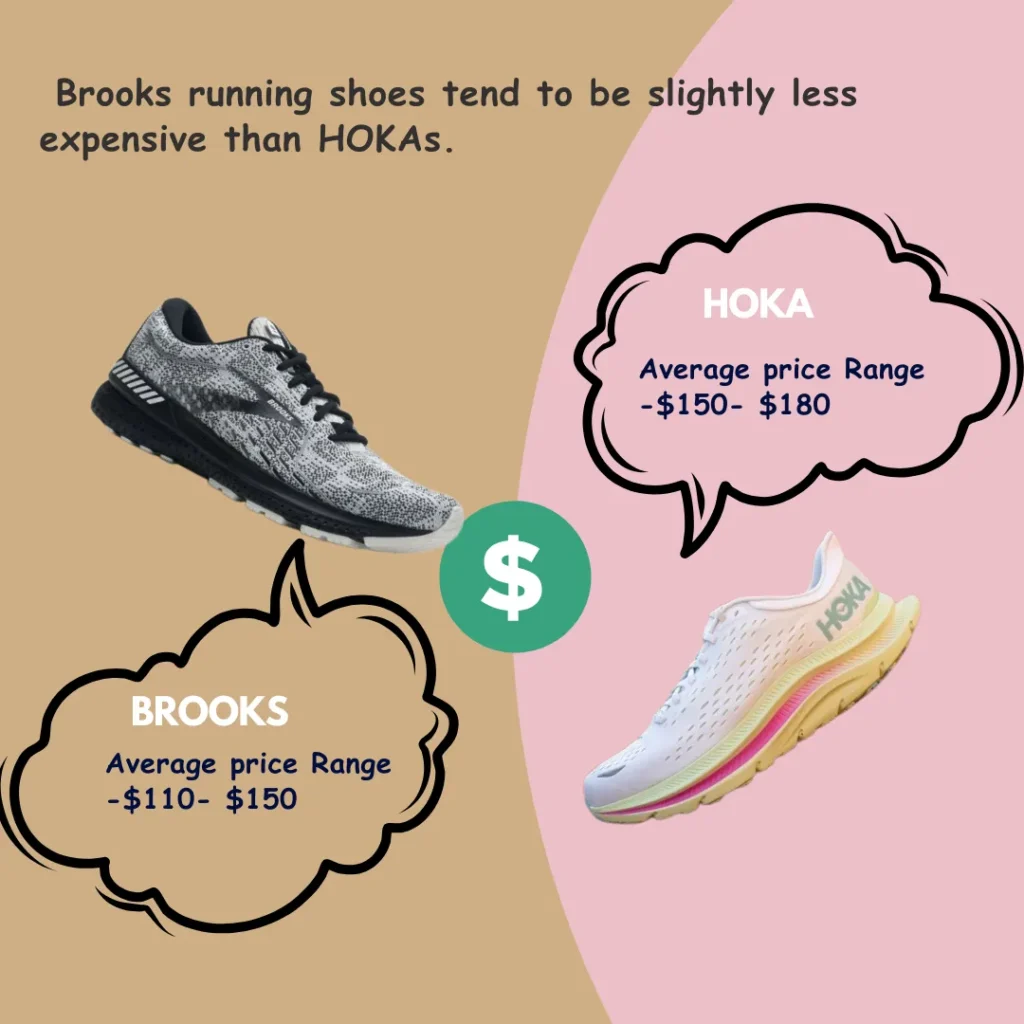
Also Read – Brooks Ghost 15 vs Brooks Adrenaline GTS 22: A Comprehensive Comparison
Are Hoka better than Brooks in running shoes?
HOKA is known for its maximalist design, offering incredible cushioning that makes you feel like you’re running on clouds.
If you’re someone who craves a plush and comfortable ride, especially for longer distances, or if you’re prone to joint issues, HOKA could be your go-to choice.
On the other hand, Brooks offers a wide range of running shoes with varying levels of support and pronation control, so if you’re looking for a more traditional running shoe that still offers excellent performance and durability, Brooks might be your ideal pick.
Ultimately, it boils down to what feels best on your feet and suits your running style.
I’d recommend trying on both brands, maybe even testing them out during a short run, to see which one feels like the perfect fit for you.
You MAy Also Like – Brooks Cascadia 16 vs Catamount 2: Which Running Shoe is Right for You?
Final Thoughts
In conclusion, the choice between HOKA and Brooks running shoes ultimately hinges on your individual preferences, running style, and specific requirements.
Both brands offer excellent options, and understanding their differences will help you find the perfect pair of running shoes to support your running journey.
FAQs
Which brand, HOKA or Brooks, is better for long-distance running?
HOKA is often favored by long-distance runners due to its maximal cushioning, which provides excellent shock absorption over extended periods.
However, some runners may prefer Brooks for its stability and durability, making it suitable for longer runs as well.
The choice ultimately depends on individual preferences and needs.
Are HOKA shoes more suitable for people with narrow feet, and are Brooks shoes better for those with wider feet?
Yes, HOKA shoes are generally narrower in design, making them a preferred choice for individuals with narrower feet.
In contrast, Brooks shoes tend to have a slightly wider fit, which can be more comfortable for those with wider feet.
It’s essential to consider your foot width when choosing between the two brands.
What is the typical lifespan of HOKA and Brooks running shoes?
Brooks running shoes typically last between 300 to 500 miles or three to six months, depending on how frequently you use them.
HOKA shoes, while durable, may have a slightly shorter lifespan due to their maximal cushioning, which can wear out faster with extensive use.
Regularly assessing the condition of your shoes is crucial for determining when they need replacement.
Which brand, HOKA or Brooks, offers better cushioning and shock absorption?
HOKA is renowned for its superior cushioning and shock absorption.
Their shoes feature maximal cushioning that provides a plush and comfortable ride, reducing the impact on joints and muscles during runs.
Brooks also offers excellent cushioning, but HOKA generally takes the lead in this category.
If cushioning is your top priority, HOKA may be the better choice for you.
Can HOKA or Brooks shoes help with knee pain during running?
Both HOKA and Brooks offer features that can help alleviate knee pain.
HOKA’s maximal cushioning can provide a softer landing, reducing the impact on knees and potentially easing discomfort.
Brooks, with its stability and support features, can also assist in maintaining proper alignment and reducing the risk of knee injuries.
It’s advisable to consult with a healthcare professional or a specialized running store to determine which brand and model may be more suitable for your specific knee concerns.
Do HOKA or Brooks offer racing shoes for competitive runners?
Brooks has a well-established line of racing shoes, making it a trusted choice for competitive runners.
These shoes are designed to enhance speed and performance during races.
While HOKA primarily focuses on cushioned and comfortable running shoes, they may not have as extensive a selection of racing-specific models.
If you’re a competitive runner seeking racing shoes, Brooks might be the brand of choice for you.
Are there any significant differences in the outsoles of HOKA and Brooks shoes?
Yes, there are notable differences in the outsoles of HOKA and Brooks shoes.
Brooks outsoles are generally more robust, with a significant portion of the shoe bottom covered by a thick layer of durable material.
This design enhances the longevity of Brooks shoes, making them suitable for various terrains.
In contrast, HOKA shoes may have smaller exposed midsole areas, which can impact durability, especially in rough conditions.
Consider the type of terrain you plan to run on when choosing between the two brands.
Are there specific sizing differences between HOKA and Brooks shoes?
Yes, there can be sizing differences between HOKA and Brooks shoes.
If you opt for Brooks running shoes, it’s often recommended to size up by half a size compared to your daily shoe size.
This adjustment can help ensure a more comfortable fit, especially if you plan to use them for running.
HOKA shoes, on the other hand, may have more consistent sizing, but it’s essential to consult the specific sizing guidelines provided by each brand to find the perfect fit for your feet.
Which brand, HOKA or Brooks, offers better options for stability shoes?
Brooks tends to excel in the stability shoe category.
They offer a wide range of stability running shoes designed to support runners with overpronation or those seeking additional stability during their runs.
HOKA also offers stability options, but Brooks is often preferred by individuals specifically looking for stability-focused footwear.
If stability is a crucial factor for your running needs, exploring Brooks’ stability shoe lineup is a good starting point.